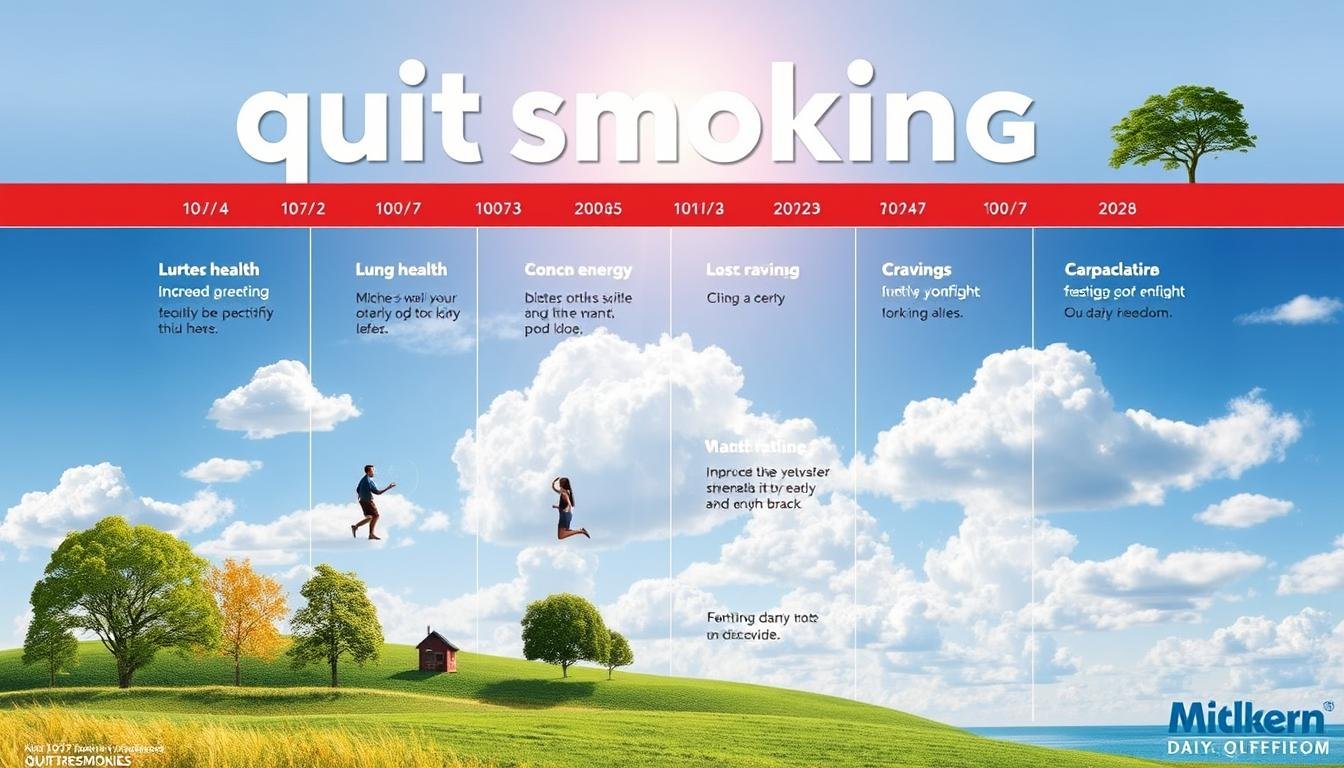Ever thought about how the first days of quitting smoking can change your future? Tracking your progress day by day is more than just counting days. It shows the power of each smoke-free moment. It helps you see the physical and emotional changes, boosting your commitment to quit.
Your body starts healing right after you quit. For example, your heart rate and blood pressure drop within 20 minutes. This is the start of a healthier life1. Knowing what to expect helps you deal with withdrawal symptoms like irritability and cravings, which start within 12 hours2.
Having a clear quit smoking timeline helps you see your body’s recovery stages. You’ll learn how your lungs improve in two weeks and your heart disease risk drops in a year1. This knowledge keeps you hopeful and informed on your journey.
Embracing the quit smoking timeline day by day strengthens your resolve. It reminds you of your progress and motivates you to keep going. Are you ready to see how each day brings you closer to being smoke-free?
Key Takeaways
- The quit smoking timeline offers critical insights into your body’s healing process.
- Your heart and blood pressure begin to improve as soon as 20 minutes after quitting.
- Withdrawal symptoms typically manifest within 12 hours and can affect your emotional well-being.
- Understanding your body’s recovery stages encourages motivation and commitment.
- Celebrating daily milestones reinforces the benefits of quitting smoking daily.
Understanding the Quit Smoking Timeline
The quit smoking timeline is key in your smoking cessation journey. It shows the changes in your body and mind as you quit. Each day after your last cigarette is a milestone, with your body healing and withdrawal symptoms easing.
Health benefits show up fast. For example, your blood pressure and heart rate return to normal in just 20 minutes after quitting. By 24 hours, your risk of heart attack drops a lot3. Also, your body starts to get more oxygen, thanks to lower carbon monoxide levels in 12 hours4.
Quitting smoking has its ups and downs. But, you’ll see lung function improve by up to 30% in the first two weeks4. As time goes on, breathing gets easier, and you’ll feel more energetic. After six months, your body heals a lot, making it easier to breathe and feel less discomfort5.
Knowing this timeline helps you prepare for challenges and stay on track. Each day is a step towards a healthier life, showing you’re making progress in quitting smoking.
As you stay smoke-free, the benefits keep growing, making it easier to stay away from cigarettes.
Using resources and making a quitting plan can help you succeed. For more tips on your quit smoking timeline, check out this link.
Understanding the quit smoking timeline can help you quit for good. It shows that every day without smoking brings you closer to a healthier, happier life5.
The Role of Nicotine in Smoking Addiction
Nicotine is the main addictive part in tobacco, changing brain chemistry and making people feel good. It’s as addictive as heroin or cocaine, showing how important nicotine is in addiction. When people stop using it, they face many challenges with nicotine withdrawal as their body gets used to not having it.
Knowing how nicotine affects addiction helps you understand smoking cessation progress better. Symptoms of withdrawal start between 4 to 24 hours after the last cigarette, getting worse around day three. About half of all smokers feel irritable, anxious, and have strong cravings to smoke6.
But, most people say these symptoms are mild to moderate and get better over time, usually in 3 to 4 weeks7.
There are ways to deal with these symptoms. Doing regular exercise, avoiding triggers, and getting help from professionals can help7. Also, using nicotine replacement therapy (NRT) can make quitting 50-60% more likely7. Knowing this helps you prepare for the emotional and physical challenges of quitting smoking.

How Withdrawal Symptoms Affect Your Cessation Journey
Dealing with smoking withdrawal symptoms every day is a big part of quitting. Knowing the common symptoms helps you get ready and plan well. Symptoms like strong cravings and mood changes vary but usually hit soon after you stop smoking.
Common Withdrawal Symptoms
Here are some common symptoms:
- Intense nicotine cravings
- Irritability
- Anxiety
- Difficulty concentrating
- Physical symptoms such as nausea and sweating
It’s key to watch when symptoms show up. Cravings can start as soon as four hours after your last cigarette. Physical symptoms get worse around ten hours later. By 24 hours, you’ll notice you’re not getting nicotine anymore. Cravings get stronger for a few days but start to fade by 72 hours8.
This knowledge helps you deal with cravings better.
Duration and Intensity of Symptoms
Withdrawal symptoms can last a month for most people. Some might feel them for just two weeks, while others face symptoms for months8. Symptoms are usually worst in the first week, especially the first three days. You might feel angry, frustrated, or anxious, which can last two to four weeks9.
Managing these symptoms well is crucial. Having a support system, avoiding triggers, and talking to doctors about help like nicotine replacement therapy can help a lot. Staying healthy can also help you avoid weight gain after quitting9.
The First 24 Hours After Quitting
Quitting smoking starts with the first day. Your body changes a lot in this time. Knowing the benefits of quitting can motivate you a lot.
For example, your heart rate and blood pressure drop to normal in just 20 minutes. By 12 hours, your blood’s carbon monoxide levels go back to normal. This means better oxygen flow and lung function later on10.
Physical Changes Within the First Hours
Your body starts healing right after you quit. Nicotine leaves your blood the next day. Without it, your health improves quickly.
Smokers often feel cravings early on. But knowing these feelings are temporary helps you stay focused. Over 70% of smokers face cravings and increased appetite for weeks11.
Emotional Challenges After One Day
The first day tests your willpower and mental health. You might feel irritable or anxious. This can affect your mood and focus.
About 60% of quitters face these feelings for a month11. Having a support network and doing activities like exercise can help. It makes the transition easier.

Days 2-3: Confronting Nicotine Cravings
The first few days without smoking can be tough. It’s key to understand nicotine cravings, as they get stronger. Knowing what makes you want to smoke is also important for managing cravings.
Understanding Cravings and Their Triggers
After you stop smoking, you might feel cravings, anxiety, and irritability. These feelings can last for weeks. Knowing what triggers your cravings helps you avoid or manage them better.
Strategies to Manage Cravings
There are ways to handle cravings. Here are some quit smoking tips to try every day:
- Practice deep breathing exercises to relax.
- Stay hydrated by drinking plenty of water.
- Engage in activities that keep you occupied and distracted.
- Identify alternative coping mechanisms to replace smoking.
Having a quitting plan can also help. It keeps you focused and lowers the chance of going back to smoking. A plan with cravings management strategies gives you a strong support system.
Cravings are usually at their peak two to three days after quitting. Having people to support you is crucial. For more on nicotine withdrawal, including timelines, check out this resource here12.
Quit Smoking Timeline Day By Day: Days 4-7
Days 4 to 7 are key in your recovery after quitting smoking. Your lungs start to work better, and your heart attack risk goes down. Your body is getting rid of toxins and fixing damaged tissues, showing the many quit smoking benefits.
Knowing these changes can really help you stay motivated to quit smoking every day.
Body’s Recovery Stages
By day 4 to 7, you’ll notice big changes. Your lungs are better at getting oxygen, which is good for your health. Using nicotine replacement therapy can help you quit up to 70% more, showing it’s effective13.
If you need help, quitlines are here for you in the U.S. They offer support through every challenge.
Maintaining Motivation During the First Week
It’s important to stay motivated to quit smoking for good. Setting small goals and rewarding yourself can boost your motivation. About 90% of people quit without help, so joining support groups or using social networks can help you stay on track13.
Remember, it’s okay to slip up sometimes. Seeing these moments as chances to learn can help you handle cravings better13.

The Importance of Healthy Habits After Quitting
After quitting smoking, it’s key to start healthy habits after quitting smoking. Eating well helps your body heal. Exercise boosts lung function and overall health.
Mindfulness helps with stress, which can lead to cravings. These habits not only aid in recovery but also boost your confidence and self-esteem.
Quitting smoking brings many benefits. You’ll notice better taste and smell, and your breath will improve. Your teeth and fingernails will also stop yellowing. Quitting before 40 can cut your risk of smoking-related illnesses by about 90%14.
Use resources like the National Cancer Institute Quitline and SmokefreeTXT for support15. Personalized quit plans and community support can greatly help your journey.
Benefits of Quitting Smoking Daily
Quitting smoking brings quick and lasting health gains that make life better. Knowing these benefits can motivate you to stay on the path to health.
Immediate Health Improvements
Feeling the benefits of quitting smoking starts fast. Just 20 minutes after quitting, your heart rate returns to normal16. This is the beginning of many health improvements.
After 8 hours, your body’s oxygen levels start to go back up. At the same time, harmful carbon monoxide levels cut in half16. In 48 hours, your sense of taste and smell gets better, and your lungs start to clear out mucus16.
By 72 hours, breathing gets easier, and you feel more energetic16.
Long-Term Health Benefits
Quitting smoking has big long-term health perks. It can add up to 10 years to your life17. The risk of heart disease drops quickly, becoming as low as a non-smoker’s after 15 years17.
Lung cancer risk halves after 10 to 15 years without smoking17. Mouth, throat, and voice box cancers also see a drop in risk over time17.
Overall, quitting smoking greatly lowers the risk of heart disease and lung problems. This leads to a healthier, longer life17.

Smoking Cessation Stages Explained
Knowing the smoking cessation stages is key for those trying to quit. The journey has three main parts: preparation, action, and maintenance. Each stage has its own hurdles and achievements to recognize for a successful quit.
Preparation is about setting your quit date and learning about withdrawal symptoms. It’s important to understand that nicotine addiction is mostly mental, with only 1% being physical18. As you start the action stage, you might face cravings and mood swings soon after quitting19. Knowing this is crucial, as most people relapse in the first two weeks19.
In the maintenance stage, it’s vital to find ways to deal with cravings and triggers. Quitting smoking brings quick health benefits, like a faster heart rate drop and lower heart attack risk after just one day20. Knowing that withdrawal symptoms can last weeks helps you prepare and manage them better. Using techniques like the Five D’s can help you overcome challenges19.
Understanding these stages prepares you for what’s ahead and helps you celebrate your progress. Every milestone, like a week without smoking or better lung function after a few months, shows you’re on the right path20.
Tracking Your Quit Smoking Progress
Tracking your progress in quitting smoking is key to a healthier life. A quit smoking progress tracker shows your wins and helps you stay on track. It lets you see your milestones, cravings, and feelings to spot smoking triggers.
Utilizing a Quit Smoking Progress Tracker
This tool is a great motivator on your journey. By logging daily, you see how far you’ve traveled. For example, staying smoke-free for a week boosts your chances of quitting by nine times21.
Seeing your savings from not buying cigarettes also boosts your drive. The Quit Tracker app is a popular choice. It’s easy to use, tracks your progress, and rewards you for milestones22. Success stories, like someone who stayed smoke-free for almost six months, inspire new quitters22.
Setting Achievable Milestones
Setting milestones is vital for staying motivated. Breaking your journey into smaller parts lets you celebrate each success. For instance, finishing your first week without cigarettes is a big deal. After a month without tobacco, you’ll think about it less21.
Tracking your progress helps you overcome obstacles. Use a 31-day calendar to mark your milestones. With the right tools, you’re on your way to long-term success.
![]()
In summary, using a quit smoking progress tracker and setting milestones are crucial for success. These strategies keep you informed and motivated23.
Overcoming Challenges in Your Smoking Cessation Journey
Quitting smoking can be tough, with cravings and mood swings being big hurdles. These challenges can lead to relapse. A study shows that smokers often feel strong cravings due to different triggers24. To fight these cravings, try keeping healthy snacks like carrots or sugar-free gum handy. They can help distract you from the urge to smoke.
Feeling angry or anxious is common when you first quit. Talking positively to yourself and finding ways to relax can help manage stress24. Also, getting support from loved ones or professionals can greatly help you stay on track. With the right strategies, you can lower your chance of going back to smoking.
Having a supportive environment can boost your success in quitting. Doing physical activities and setting small goals, like staying smoke-free for a day, can motivate you25. Rewarding yourself for these achievements, like downloading music or going out, keeps your motivation up. Remember, it’s okay to have setbacks, but don’t let them stop you from your goal25.
Motivation Techniques for Daily Success
Using motivation techniques is key to quitting smoking every day. Keeping a journal helps track your progress and think about your journey. Visualizing a smoke-free life boosts your determination.
Being around supportive people increases your success chances. Getting professional help also gives you more guidance and support.
It’s important to celebrate your milestones. Acknowledge every small victory to build positive reinforcement. Make a list of rewards for reaching your quitting goals. These can be simple treats or fun experiences.

Smoking kills over 24,000 Australians each year, showing how urgent quitting is26. Using Nicotine Replacement Therapy (NRT) can double your chances of quitting27. The first two weeks are crucial, especially with strong motivation techniques27. A structured approach helps manage cravings and keeps you on track.
Impact of Quitting Smoking on Mental Health
Quitting smoking can greatly improve your mental health over time. At first, you might feel more anxious. But studies show that most people who quit for six weeks or more feel less depressed, anxious, and stressed than smokers28. You can start to feel emotionally better in just six weeks20.
Smoking has a big negative impact on mental health. Smokers tend to have lower mental well-being scores than others. This shows how smoking affects your emotional health28. Sadly, smokers are more likely to have anxiety and depression, leading to higher death rates, especially for those with mental health issues28.
Knowing that quitting will improve both your physical and mental health can motivate you. Quitting for a year cuts down your heart attack risk a lot. It also helps you stay mentally well for the long term29. The path to quitting might be tough, but knowing the benefits can help you stay smoke-free.
Celebrating Milestones in Your Stop Smoking Journey
Celebrating milestones is key to your stop smoking success. Every big win, like a week, month, or year without smoking, is worth celebrating. These celebrations boost your motivation and show you’re serious about quitting.
Think about making a visual like a calendar or chart to track your progress. Each day you don’t smoke is a victory. These reminders can keep you motivated and focused on your goal.
| Milestone | Emotion/Reaction | Recommended Reward |
|---|---|---|
| 1 Week | Relief and Pride | Enjoy a favorite meal |
| 1 Month | Confidence Boost | Buy a new book or hobby item |
| 3 Months | Empowerment | Take a weekend trip |
| 6 Months | Excitement | Spa day or self-care ritual |
| 1 Year | Joy and Accomplishment | Throw a small celebration party |
Remember, celebrating your wins is powerful. It keeps you focused and shows the good changes in your life. Sharing your journey with others can also strengthen your support network. Every day without smoking is a big win on your path to a healthier life303132.

Quitting Smoking and Lifestyle Changes
Quitting smoking opens the door to big lifestyle changes after quitting cigarettes. You start to build new, healthier habits that boost your well-being. These changes help you stay smoke-free and improve your life in many ways.
Adopting New Healthy Habits
After quitting smoking, it’s key to start new healthy habits. Regular exercise, better nutrition, and stress relief are important. Activities like walking or joining a fitness class can help your body and mind.
Better food choices help your body heal from smoking’s damage. This is a big step towards a healthier life.
The good effects of these lifestyle changes after quitting cigarettes are clear. For example, your blood pressure and pulse get back to normal 20 minutes after your last cigarette3. Just one day later, your heart attack risk starts to drop20.
Also, your taste and smell get better in just two days3. This can motivate you to keep living smoke-free.
| Time Frame | Positive Changes |
|---|---|
| 20 minutes | Blood pressure and pulse normalize |
| 1 day | Reduced risk of heart attack |
| 2 days | Improved sense of taste and smell |
| 2 weeks | Up to 30% improvement in lung function |
| 3 months | Enhanced stress management and physical activity |
| 1 year | Significant improvements in lung capacity |
These lifestyle changes after quitting cigarettes not only make you healthier but also lower your chance of going back to smoking. Embracing these changes can lay a strong foundation for a smoke-free future203.
Conclusion
Tracking your quit smoking timeline day by day is key to managing the challenges of quitting. Knowing the importance of planning helps you prepare for tough times like withdrawal and cravings. This way, you can use strategies to stay strong and keep going.
Also, seeing the health benefits of quitting will boost your will to stay smoke-free. Every day, you’ll notice improvements that make your effort worth it. Studies show that setting goals early can help you stay on track and succeed in quitting33.
With hard work, support, and knowing your progress, you can live a healthier life without smoke. This journey not only improves your health but also your overall life quality. For more on the benefits of quitting early, check out this study34.
FAQ
Why is tracking my quit smoking timeline day by day important?
What are some common withdrawal symptoms I might experience when quitting smoking?
How long do withdrawal symptoms last after quitting smoking?
What physical changes should I expect within the first 24 hours after quitting?
What triggers nicotine cravings, and how can I manage them?
What should I focus on during days 4 to 7 after quitting?
How can I establish healthy habits after quitting smoking?
What are the immediate health benefits of quitting smoking?
What are the long-term health benefits of quitting smoking?
What strategies can I use to track my quitting progress?
How do I celebrate milestones in my quitting journey?
How does quitting smoking impact my mental health?
Source Links
- https://truthinitiative.org/research-resources/quitting-smoking-vaping/breath-fresh-air-immediate-benefits-quitting-smoking-or
- https://www.realigndetox.com/orange-county-detox/nicotine-withdrawal-timeline/
- https://www.healthline.com/health/what-happens-when-you-quit-smoking
- https://www.verywellmind.com/after-you-quit-smoking-the-first-two-days-2824391
- https://www.snhhealth.org/blog/november2024/a-timeline-of-what-happens-after-you-quit-smoking
- https://www.verywellmind.com/what-to-expect-from-nicotine-withdrawal-22467
- https://www.medicalnewstoday.com/articles/323012
- https://www.healthline.com/health/quit-smoking/nicotine-withdrawal-timeline
- https://www.cancer.gov/about-cancer/causes-prevention/risk/tobacco/withdrawal-fact-sheet
- https://www.verywellhealth.com/what-happens-when-you-quit-smoking-7561262
- https://tobaccofreelife.org/quit-smoking/quit-smoking-timeline/
- https://www.nicoderm.ca/get-ready-to-quit/quit-smoking-timeline-what-happens-when-you-quit
- https://www.webmd.com/smoking-cessation/quit-smoking
- https://www.cancer.org/cancer/risk-prevention/tobacco/guide-quitting-smoking/benefits-of-quitting-smoking-over-time.html
- https://smokefree.gov/quit-smoking/getting-started/steps-to-manage-quit-day
- https://www.nhs.uk/better-health/quit-smoking/
- https://www.cdc.gov/tobacco/about/benefits-of-quitting.html
- https://www.allencarr.com/easyway-stop-smoking/nicotine-withdrawal-timeline/
- https://www.webmd.com/smoking-cessation/understanding-nicotine-withdrawal-symptoms
- https://www.medicalnewstoday.com/articles/317956
- https://okhelpline.com/quit-tobacco-with-our-31-day-calendar-tips-and-inspiration/
- https://play.google.com/store/apps/details?id=com.despdev.quitsmoking
- https://bewellshbp.com/tobacco-cessation/how-tracking-can-help-you-quit-smoking-and-5-more-tips-to-quit/
- https://www.cancer.org/cancer/risk-prevention/tobacco/guide-quitting-smoking/quitting-smoking-help-for-cravings-and-tough-situations.html
- https://www.lung.org/quit-smoking/i-want-to-quit/what-to-expect
- https://www.quitclinics.com/blog/how-to-gradually-quit-smoking-tips/
- https://www.addictionsandrecovery.org/quit-smoking/how-to-quit-smoking-plan.htm
- https://www.gateshead.gov.uk/article/17794/Quitting-smoking-can-boost-mental-health-in-just-six-weeks-stop-this-No-Smoking-Day-Wed-March-10
- https://www.nhs.uk/better-health/quit-smoking/why-quit-smoking/benefits-of-quitting-smoking/
- https://onlinedoctor.lloydspharmacy.com/uk/lifestyle-advice/stop-smoking-timeline
- https://assets.ctfassets.net/b7vjv6cc1lvj/2hEi6mWpJQc0foXE1dBQ1l/c3c55dde079f53c50bb23f1aa9fd1452/my_quit_guide.pdf
- https://www.canada.ca/en/health-canada/services/smoking-tobacco/quit-smoking/after-you-quit.html
- https://pmc.ncbi.nlm.nih.gov/articles/PMC2725010/
- https://ash.org.uk/resources/view/stopping-smoking




